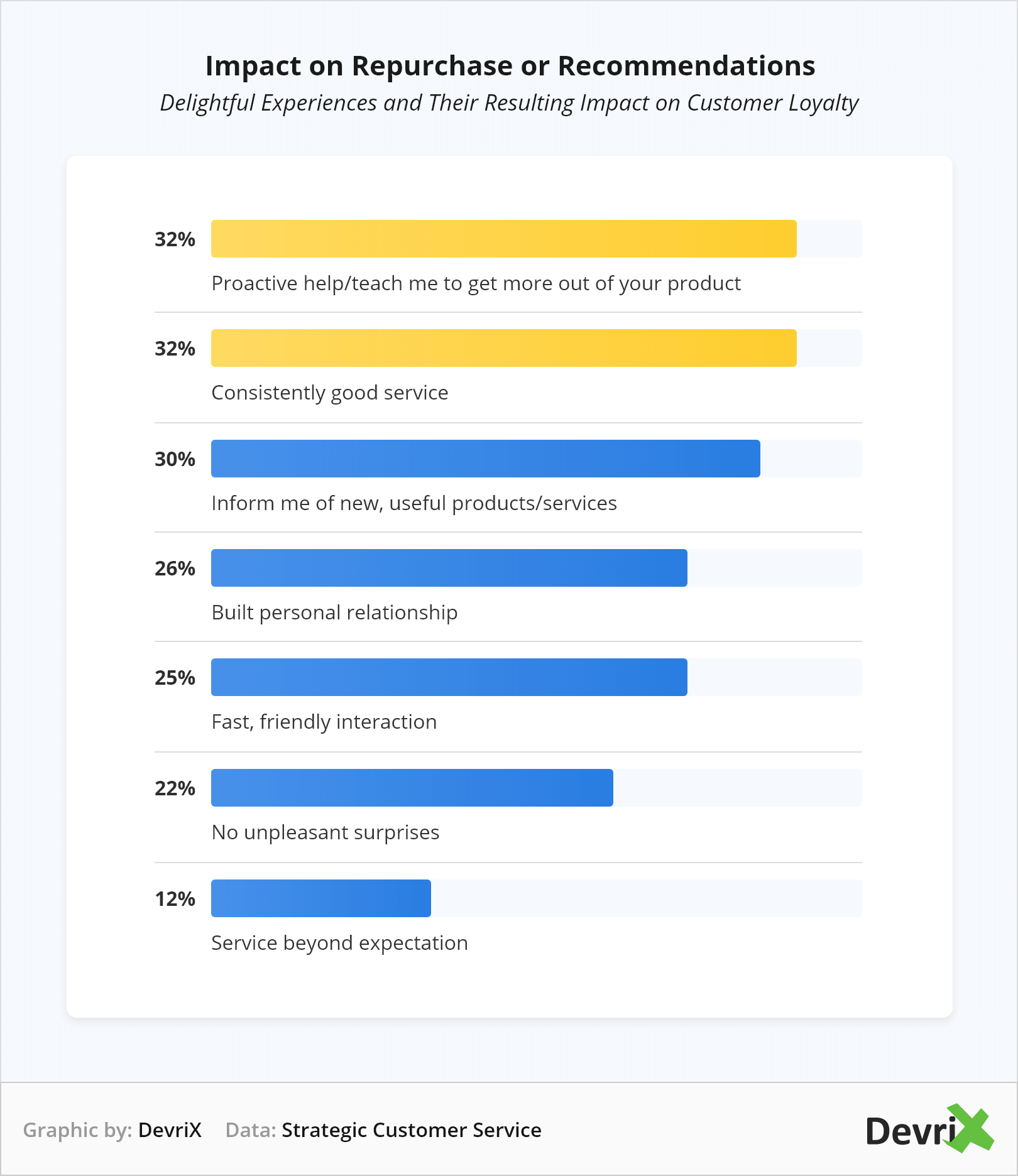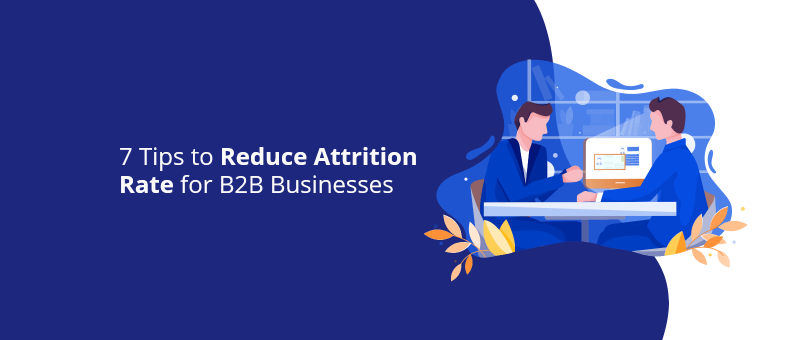Having a high attrition rate is a dreadful ordeal for any B2B business owner. In fact, US companies lose over $136 billion per year due to avoidable customer switching.
What Does ‘Attrition Rate’ Mean?
Customer attrition rate, also known as customer churn rate, is the rate at which you lose existing customers. This can significantly reduce your revenue and reduces your ability to grow as a company. For instance, if you started Q1 with 1000 customers, and by the end of the quarter, you lost 75 customers. This means you have an attrition or churn rate of 7.5%.

Why Should You Worry About It?
As mentioned above, high attrition rates reduce revenue and business growth potential. However, it is also a good indicator that something is not working. Whether that’s the way the business is being conducted or how the clients are being handled. In simple terms, the B2B customers aren’t being provided with what they signed up for.
Let’s say that you’re a business that develops cloud-based call center software. A high attrition rate could point to problems with the software itself, a too-high price point, or a lack of customer support. Knowing the attrition rate isn’t enough – you’ll also need to figure out the cause.
Challenges for B2B Businesses
B2B businesses face specific and unique churn problems that need to be understood. High customer attrition rates come about from:
- High employee turnover. B2B customers often form bonds with certain people at your company. If these employees leave, customer loyalty can be undermined.
- Uncontrollable factors. Regardless of the effort and quality you provide, high-risk B2B customer businesses can often fail – especially smaller businesses and startups.
- Large B2B customers. The more your business grows the larger the clients you take on. However, many businesses take on larger clients without having the required dedicated teams to handle them.
- Value. An important aspect and a major reason for customer churn is the lack of value. Value is a complicated concept with varying definitions that change from customer to customer. Without value, it is impossible to retain clients. We will discuss this idea further throughout this article.
All organizations endure churn, whether you’re a business that provides a free web conferencing tool or truffles to restaurants. But there are ways to reduce it.
Here are our top tips to help your B2B business reduce its attrition rate.
1. Onboarding
Aligning with customers’ expectations during the onboarding stage is a vital factor in reducing your attrition rate. Working with a new B2B business can be an overwhelming process. If your client isn’t aware of your capabilities, how to navigate your service, and their options for support and solutions, they are likely to lose interest.
In fact, statistics show that:
- A great onboarding process can increase retention by 82%.
- Onboarding can also boost productivity by 70%.
- 88% of organizations don’t conduct good and efficient onboarding.
An onboarding process should be structured and focus on your customers as people rather than just as paperwork. Many businesses (58%) fall into the trap of an admin focused onboarding process.
Onboarding Advantages
Onboarding is important as it allows you to get on the same page about your service and how you will benefit the customer. If your business provides VoIP then your customer needs to know all the VoIP advantages.
It helps the customer understand whether or not you can fulfill their needs. It also enables the customer to decide, early on, whether your price is too high for their budget and if they need to move in a different direction.
Crucially, onboarding allows you to define the value of your business. If you are successful in providing the deliverables then you have proven your value and will need to redefine it moving forward.
A good technique to ensure that your customer understands the scope of the project and what your business can provide is by providing training. Whether that’s demos, tutorials or guides, good education makes the onboarding process much simpler.
2. Communication
At the core of a strong business relationship is trust. This can only come about when there is honesty and transparency. Without human-to-human interactions and good communication, loyalty, and retention are difficult to guarantee.
Waiting for your customers to reach out to you is detrimental to your overall customer experience. Communication shouldn’t be a reactive process. Developing proactive communication shows your customer that you are invested in their process and want to help them to get the most out of your business.
Proactive communication techniques include:
- Anticipating customer needs.
- Analyzing how the customer is using your service and providing tips or pointers, if necessary.
- Analyzing the customer’s relationship with your customer support team and informing them how they can leverage the team to their advantage in the future.
- Starting more conversations to discuss any issues they may be having.
Strong communication is only possible through efficient communication channels. This can include calls, email, and face-to-face communication. If you have to adjust your communication and work remotely, then you need to figure out the best video conferencing solution for both parties.
What’s in It for You?
Proactive communication is not only useful for the customer, but this engagement allows you to constantly present the value of your business.
Sharing with the customer your latest updates, how you’re better than competitors and your benefits are important factors in reducing attrition rate. B2B businesses often see a prolonged sales cycle, so continuous communication is vital.
3. Acquire Attrition Rate Data
Before beginning to address and deal with the problem of churn, you need to identify the root of the problem. Successful business decisions begin with carrying out internal research and collecting data.
Similar to the points made above, if you’re delaying your research until after your attrition rate has skyrocketed (a reactive approach), then it’s too late. You should be constantly acquiring insights about your customers and building effective strategies to prevent churn. In addition to identifying the weak points, you should also identify your strengths that have led to retention.
Here are a variety of techniques you can use to obtain data from customers that may churn in the future or that are choosing to end their relationship with you:
- Create a customer exit survey. If a customer is ending their business relationship with you it is important to provide a short, concise exit survey. This should be more detailed than just “why are you leaving?”. It should include questions about: customer service, communication practice, expectations, etc.
- Communicate when sales drop off. It is important to use data to detect churn and immediately contact customers that express these churn symptoms. Understanding why sales are dropping and asking the right questions may retain your customer. Questions like: Have you found a better price elsewhere? Have you endured a bad experience with us?
- Follow up with the onboarding. Ensuring that customers have fully completed the onboarding process is important in defining the value of your company.
4. Analyze Attrition Rate Data
After collecting churn data it’s important to analyze and produce findings to increase your business intelligence.
The goal of the analysis stage is to find out why customers are leaving. Understanding these patterns and trends will allow you to reduce churn in the future. Not only that, it allows you to predict the “at-risk customers” and enables you to create specific packages designed to re-engage them.
Here are some common trends businesses find after attrition analysis:
- Negative customer experience.
- Competitors are providing a more suitable price point.
- Business failing to deliver on promises.
- Lack of a personalized, business-specific experience.
- Lack of brand alignment.

5. Provide Service and Support
There are many, multifaceted answers to the question “what is world-class customer service?”. According to research, 66% of people agree that good customer service and support is the most important thing a business can do. Almost 74% of consumers switch consumers after experiencing bad customer support.
Providing poor customer service will not only increase your attrition rate but can also adversely affect your brand image. Unhappy customers can lead to negativity in reviews and through word-of-mouth, tarnishing a company’s reputation.
Providing collaborative and interactive service that allows your B2B customers access to various support channels is a vital technique for reducing attrition rate. Carrying out routine check-ins with your customers is fine. But what they really want is a personalized service.
Support can come in many forms such as direct interaction but it can also come in the form of providing expertise. Value, especially in the case of B2B customers, can be defined as access to information, best practices, and webinars.
Virtual events are great because they allow you to connect, spread knowledge, and increase customer satisfaction. If used correctly, webinars can bring value to your company and become an important differentiator.
Good customer support can also include allowing B2B customers to work and form bonds with the same team. The team the customer interacts with shouldn’t be constantly changing due to employee turnover. Working with the same team increases the understanding between the business and B2B customers, sharing of information, productivity, and overall retention.

6. Feedback
We have spoken about actively collecting and leveraging data to reduce your attrition rate, but sometimes the customer can provide you with everything you need to know to prevent them from churning.
In the same way that you develop a marketing message and strategy to talk to your audience, you have to find a way for your audience to talk back. A customer’s criticism or complaint is defined as the gap between what a business has promised and what the customer has actually received.
A key factor in reducing attrition rate is building a platform where customers can record their complaints. Only 1 in 26 customers complain, the rest just stop working with your business without saying anything. This is why listening to complaints, collecting customer insights, and addressing the issues is crucial.
Another important element to consider is transparency. There is no use in burying
customer complaints and negative reviews. Complaints should be openly shared with employees and discussed to ensure that, next time, the necessary change is made.
7. Rewards
Creating customer rewards is a good way to make your clients feel appreciated and show them that you have developed a customer-centric culture. However, providing your customers with incentives, discounts and promotions should be an additional element not as compensation for bad quality service.
Here are some examples of B2B business rewards:
- Loyalty packages. These can make your customers feel VIP. However, it’s important to personalize these loyalty packages, as they’re now commonplace.
- Promote values. Knowing your customer’s business values can allow you to provide specific incentives such as donations to their chosen charities.
- Discounts. In the B2B world discounts can be provided when customers pay invoices before the due date or product category discounts to promote seasonal goods.
- Incentive trips. Travel incentives such as corporate events or summit meetings are one of the most effective ways to strengthen your relationship with your B2B customers. Travelling gives you the chance to create an engaging and informative experience that customers will remember.
- Incentive training. This technique is beneficial for both parties as your customer increases their knowledge, increases their business success, and increases work with your company.
Wrapping Up
High attrition rates can harm any B2B business, it depletes revenue and affects company growth. The theme throughout this article is finding, presenting, and defining your value. That should happen from the onset and throughout.
Present your value through good communication, customer support, and by listening to feedback. These are all central to a great customer experience strategy. It’s also important to acquire analytics to find out how and why you’re churning.
Finally, a small effort can go a long way and incentives are a good technique to show your customers that you also value their business.

